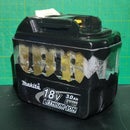Introduction: Krieg's Buzz Axe (Borderlands 2)
I've long had plans to make another prop from the Borderlands series, but with so many different weapon variants it was impossible to decide on any particular design. For another project I've been looking at getting a plasma cutter, so I turned to designs that could be made from sheet materials, and Krieg's buzz axe was an ideal match. While I haven't yet got my hands on a plasma cutter, all the planning and templates will be transferable if I do create a metal version of this prop.
With that in mind, I began construction on the first model using thick acrylic sheet as an alternative to sheet steel.
Supplies
Materials:
- 8mm Acrylic (Roughly 50cm x 50cm)
- 40cm offcut of 2"x4" timber
- Assorted nuts and bolts up to 80mm in length, with M6 to M12 threads
- Thin cloth scraps for the handle wraps
- Assorted paints (Pink, blue, brown, black acrylics, silver automotive spray paint)
- Suitable lacquer
- 6001 Bearings (28mm external diameter, 12mm hole diameter, 8mm wide)
- Epoxy and superglue
Tools:
- Jigsaw
- Angle grider with sandpaper disks
- Wood rasps and files
- Heat gun
- Airbrush (Optional, but recommended)
Step 1: Reference Images
The clearest reference images I could find were on Nico Villar's artstation page, which I used in conjunction with in game screenshots and screenshots from the trailers to get most of the angles I'd need to determine the correct proportions and generate a list of parts.
I made the decision to reduce the scale to around 2/3 for a few reasons: At the time of planning the prop, I was originally going to use a saw blade rather than make my own, and the most common 24-tooth blades that matched the axe design the closest were only available in a 210mm variant, which would put the whole axe at 66cm is scaled proportionally. Secondly, a 100cm axe would only realistically be a 2-handed weapon, and Krieg is seen almost always using it single handedly. The final limiting factor was that I only had 2x4 offcuts to work with for the handle, and to carve the wood into the right shape would require something around 11cm wide. I still had to de-emphasise the curvature slightly to reduce this from 11cm to 9.5cm, but that worked perfectly for a 66cm scale.
I also decided to include a bit of theming from the regular Psychos' axes in the form of rust detailing around the nuts and bolts.
Step 2: Carving the Handle
After reducing the image width from 11cm to 9.5cm I made a grid with intervals of 5cm, and marked points corresponding to those on the scale diagram, then used a jigsaw and angle grinder to cut out the rough shape, round off the edges and narrow the thickness in the middle.
I also used a high speed rotary tool to carve in some wood grain effects.
The cutting and carving process took well under an hour, so I used the original as a template and traced the outline for a second one for part of a future project.
Step 3: Acrylic Sections
The upper half of the axe consists of 3 main parts: The saw blade, the axle housing and the bracket that joins the housing to the handle. Since each one needed to be mirrored (And the blade thickness doubled) I needed two of each.
The fastest way to create templates was to trace the outlines of the diagram and create a black and white template, then scale the image up to a 1:1 size, lay a piece of paper on top of the monitor and gently mark a dot on each corner. After marking all the points, I joined the dots, cut the templates out, and used a light coat of spray paint to duplicate the shapes onto 8mm acrylic without having to make additional templates to stick down.
After grinding the saw blade's teeth to a point, and giving all the pieces a small bevel and sanding the edges, they were ready to be reshaped.
Step 4: Assembling the Acrylic Pieces
A strip heater would have been much more efficient at bending the acrylic to the right angles, but a heat gun worked fairly well too. My method consisted of holding the heat gun nozzle about 5cm from the area I was heating, and moving it back and forth along the bend line, flipping to the other side about every 5 seconds. By resting one end on a hard, heat proof surface I could tell exactly when the acrylic became malleable in order to avoid overheating it and causing air bubbles to appear in and on the surface of the acrylic. When heating continuously, there is usually about a 20 second window between not heating it enough to get crisp bends, and heating it so much it burns, and although it takes longer to heat 8mm acrylic than 3mm, it the acrylic's thermal mass gives you a bit more tolerance by acting as a sort of heat sink.
The elasticity of hot acrylic also means you might need to make some bends at greater angles than necessary, as they will return slightly when cooling. I had to re-bend one section of the axle housing several times due to this, although you can rely on the bolts to correct any slight discrepancies in the angles.
To bolt the pieces together, I chose nuts and bolts with visually similar designs, and thicknesses, and cut / tapered them as required. To minimise the risk of cracking the acrylic, O drilled out the holes to almost the maximum diameter of the bolts (i.e.; 5.5mm drill bit for the M6 bolts) and heated both the bolt and acrylic prior to screwing them together. A tap and die set would have been effective too, but this method was much quicker.
I made the mistake of using 2 part epoxy on most pieces without first keying them, which led to them delaminating. I re-glued the hexagonal acrylic "washer" that fits around the axel after drilling a lot of small holes a few millimetres deep, but when the two halves of the blade began to delaminate, I discovered that super glue (Cyanoacrylate) was perfect for seeping into the gaps that had separated, and in fact produced a much stronger bond than the epoxy.
Step 5: Mounting the Bearings
I bored the centre of the saw blade out to 28mm, and epoxied a pair of 28mm bearings into the gap. Although it made it much less likely to crack or cause the two halves of the blade to separate from the centre, the slight misalignment of the two bearings did mean that the blade no longer spun as smoothly once assembled (It could also be the case that in widening the hole I moved slightly off the centre, causing an imbalance).
A pair of M12 nuts either side of the bearings worked perfectly as spacers, tightly gripping the central spindle without touching the outer housing or saw blade.
Step 6: Primer and Base Coats
Prior to attaching the acrylic portions of the blade, I painted the handle with a combination of light and medium browns without allowing them to fully dry (Helping them to blend slightly) and using a black wash to darken all the crevices.
With the handle masked off, I primed all the acrylic with grey primer, and roughly masked off the acrylic panels so the blade could be spray painted silver. Once fully dried, I masked the bolts and blade, then gave everything a base coat of bright pink using an airbrush.
I then removed the masking and tried to give some areas depth by adding shadow with a medium grey (Though this would later be lost under the blue), as well as giving the blade a light misting to dull the shine down slightly. By buffing the edges before the mist coat had fully dried, it was possible to return some of the shine to the exposed edges as though they had been worn back down to shiny metal.
Step 7: Blue Paint and Rust Effect
I mixed the blue paint with a high ratio of UV pigment (About 2 parts pigment to 1 part paint, though this depends on the concentration of the pigment) and applied it using a simple stippling process. I used a drinks straw to blow "tendrils" in some areas, and softened the edges of other patches using a watered down mix in the air brush.
The final detailing steps involved creating the "cell shaded" look by drawing black lines on all the edges (Achieved by dipping a ruler in a dark paint mix and pressing it on the edges, or by carefully brushing the edges of any acute angles. I also chose to deviate from the original game design by adding rust to the bolts in the form of PVA glue, iron filings and vinegar.
Once the vinegar had fully evaporated, I sealed everything with a couple of coats of gloss lacquer.
Step 8: Completion Photos
The last step was to add a cloth wrap to the handle. This was trickier than expected, because the contours and varying thickness of the handle meant the fabric had to be either very stretchy or able to skew at up to 30° angles. Eventually I found something that worked, and gave it a light dirtying down after glueing the fabric to the handle.
The UV pigment shows up very well under UV light, even during the day, and at night it's almost blinding!

Participated in the
Fandom Contest












